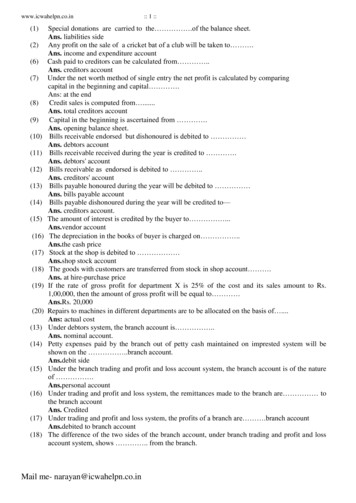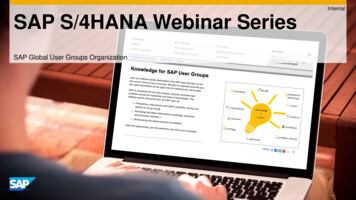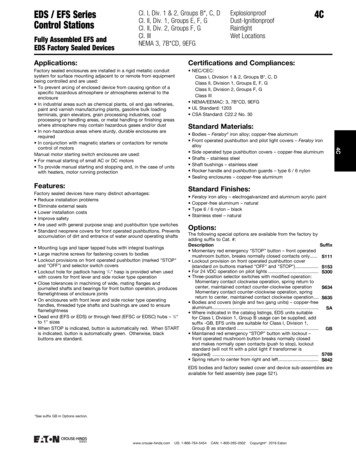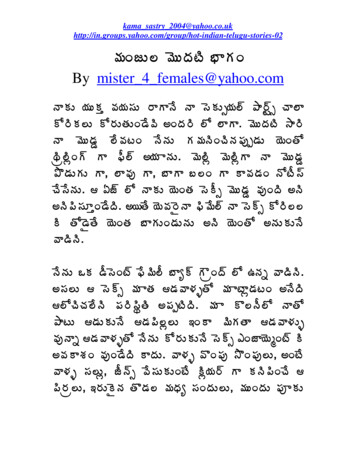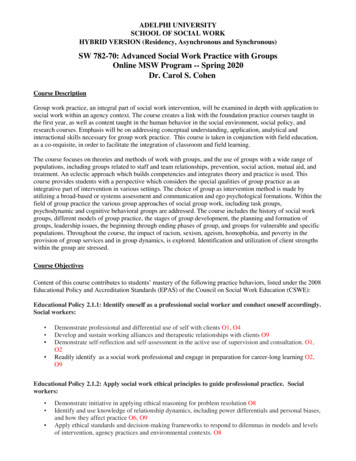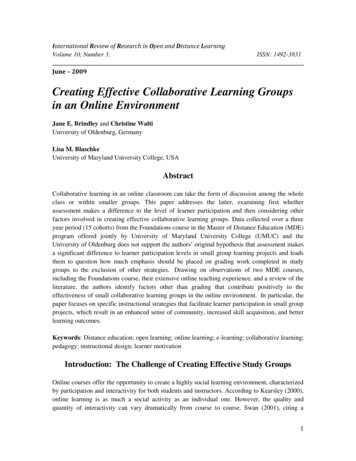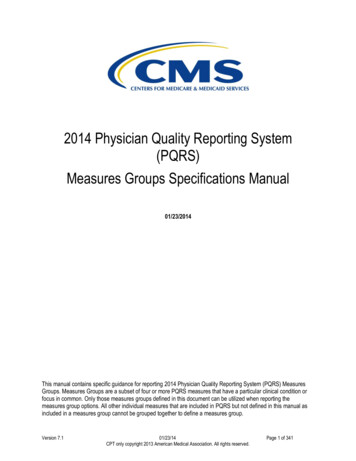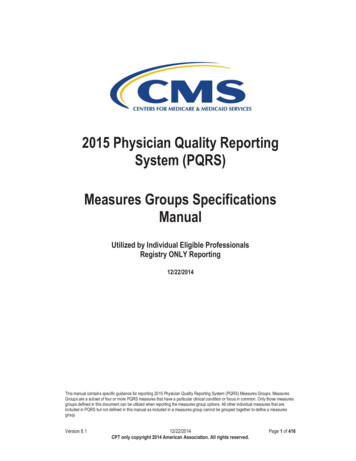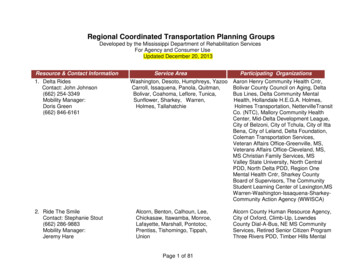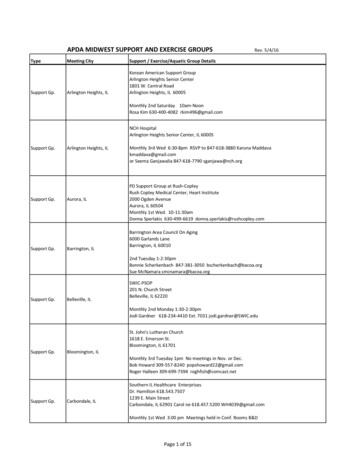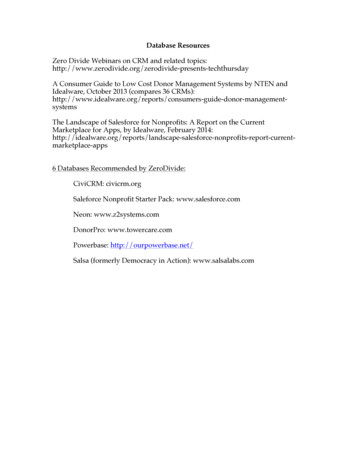
Transcription
Database ResourcesZero Divide Webinars on CRM and related ts-techthursdayA Consumer Guide to Low Cost Donor Management Systems by NTEN andIdealware, October 2013 (compares 36 uide-donor-managementsystemsThe Landscape of Salesforce for Nonprofits: A Report on the CurrentMarketplace for Apps, by Idealware, February orce-nonprofits-report-currentmarketplace-apps6 Databases Recommended by ZeroDivide:CiviCRM: civicrm.orgSaleforce Nonprofit Starter Pack: www.salesforce.comNeon: www.z2systems.comDonorPro: www.towercare.comPowerbase: http://ourpowerbase.net/Salsa (formerly Democracy in Action): www.salsalabs.com
Published on Idealware (http://www.idealware.org)Home Multiple Constituent Groups, One Database? How to Track Everyone Who’s Anyone to YouMultiple Constituent Groups, One Database?How to Track Everyone Who’s Anyone toYou[1][2]December 2011PublishDate: December 2011Author:Laura S. QuinnSince most organizations don’t track just one type of constituent, the idea of a single databasefor all of them—donors, volunteers, clients, email subscribers, advocates and everyone else—issomething of a holy grail. The ability to easily see how all your constituents interact with yourorganization, and with each other, makes for an attractive, ideal vision of what a database shouldbe.In reality, a single constituent database usually means some sort of compromise. If your nonprofittracks a wide variety of constituents but doesn’t need very deep functionality in any particulararea, it’s feasible. But if you need to keep tabs on more complex data—like tracking stock giftsfrom donors, matching volunteers with volunteer opportunities based on interests and availability,and the case notes, histories and outcomes of the mental health services provided to clients—you’re not likely to find a single system to fill all your needs.If there’s not much overlap between particular constituent groups (for example, your clients aren’tlikely to be donors, and your donors aren’t likely to become clients), there may not be enough ofan upside to a single database to make it worth your while. For many organizations, multiplesystems can be a better fit.But how do you determine which is the right solution for your nonprofit? We’ve designed a shortexercise to help you decide.Know Your AudienceThe first step is to identify all the constituents you deal with on a day-to-day basis. These are thepeople you need to track. It’s likely you’ll have not just donors and clients, but volunteers, alumni,event attendees, partners, press contacts and other groups. Include them all.
Then, choose the constituent group that’s most important for your organization to track—we’ll callthem your “Critical Constituent.” For most organizations, this will probably be either donors orclients. (If you have two or three key constituents, you can repeat the exercise for each, butchoose one to start with.)For each of the other constituent groups you identified, determine:Their relationship to your Critical Constituent—how likely are people in one group to be inthe other? Might they move between them?The complexity of thedata you need to track for them in addition to what you’re alreadytracking for Critical Constituents—the basics, like name, address and contact information,is probably the same for both, but there’s likely to be additional information.Using donors as the Critical Constituent for our example, let’s compare them to volunteers as theother constituent group. Are volunteers likely to become donors, or vice versa? Might a volunteeralso be a donor? Neither scenario is unusual for many organizations, so we could call these twoconstituents highly related. As we consider other constituent groups—press contacts, forexample, or legislators—we’re likely to find far less overlap.Next, let’s consider the complexity of the data we’ll need to track for volunteers that we don’talready track for donors. This might include the types of projects they’d like to help with, whenthey’re available, and their history volunteering with the organization. Because there are morethan a few additional fields, this falls somewhere between medium- and high-complexity,depending on the specifics.Once you’ve defined how complex and related each constituent is, plot your constituent groupson a chart for a look at your overall constituent picture.
Read Between the LinesWhat can you learn from this constituent picture? Let’s say your groups mostly cluster toward theright side of the chart. This means you don’t haveextensive additional needs on top of what you alreadytrack for Critical Constituents, and tracking them all ina single database almost certainly makes sense foryour organization. You should be able to customize adatabase optimized for your Critical Constituents to fiteveryone else, too.But what if you have a cluster down in the lower lefthand corner that shows you have some difficult-totrack constituents that aren’t particularly related toyour Critical Constituents?
You’re unlikely to find a system that effectivelysupports substantial functionality for both types ofconstituents, and given how little they relate to eachother, there may not even be much benefit in trying toshoehorn them into a single database.In this case, you’re probably better off with more thanone database—but how many do you need? Removethe Critical Constituent from the equation and repeatthis exercise just for the constituents grouped togetherin the lower left hand corner. Are they related to eachother? Do you need to track similar data for each ofthem? Again, if they don’t overlap significantly, morethan two databases might make sense.Things get more complicated if you have constituentsfloating in the middle of the chart, or even worse, inthe upper-left corner. If that’s the case at yourorganization, start weighing the possibilities andtradeoffs. It might prove difficult to incorporate theseconstituents into the same system as your CriticalConstituents. Is it worth the effort and expense?Consider whether multiple systems can be integratedso key data flows from smoothly between themthrough an automatic data feed. Integration is often expensive and complicated, but it can be agreat solution to thorny data problems like this.Wrapping it UpThe vision of a single database is attractive, but the reality might be neither practical nor costeffective for your organization. Should you track all your constituents in the same system? Only ifit makes sense for your particular situation. At the end of the day, that’s not easy to know.If there’s a compelling reason to combine everything, and the benefits outweigh the risks andcost, the dream of a single database is a viable possibility. But achieving that dream requiressome strategy and forethought—otherwise, your dream of a single database might just becomean implementation nightmare.Read [3] our case studies illustrating this article, which was originally published in the December2011 issue of the NTEN:Change journal [4].License: Creative Commons Attribution-NonCommercial-NoDerivs 2.5 [5]
Subscribe to Our NewsletterCountry: United StatesGet Products and ServicesHomeSupportMembers Log InOn the Web:Articles and How To'sCommunityResourcesSupportDonor and Grants ManagementFew Good CRM ToolsArticles andA How-TosA Few Good CRM ToolsNot yFree WebiBlogIs a constituent relationship management system a good fit forWebinarsyour nonprofit or charity?Digital StorytellingDisasterPlanning andElizabeth Pope - June24, 2013RecoveryIs a CRM system aSprucegood fit Upfor yourTake a lookYourorganization?Websiteat some of the determining factors as well asTechnology for Good Reportrecommendations about specific tools available.TechSoup hoswebinars on acloud computisocial media aThis article is courtesy of Idealware, which provides candid information tohelp nonprofits choose effective software. For more articles and reviews,go to www.idealware.org.RELATED LINKSManage Donors and ConstituentsYour organization maintains relationships with a number of people in anumber of different groups, some discrete, some overlapping, and beingable to track and manage information about those relationships is critical toyour success.For example, maybe you have a devoted volunteer who has given faithfullyto your annual campaign for years, participates in the walkathon, and gothis company to match donations his coworkers make to your organization.Ideally, you have relationships with dozens of people like him, or more. Inthe not-so-distant past, we relied on a combination of paper files,institutional knowledge, and notes in various constituent databases to trackall those details about them in a way that's accessible and actionable. Buttechnology can provide a more holistic view of constituents — to see thedifferent ways in which they're involved, and make sure they're beingshepherded to even greater levels of commitment.While some databases are designed to provide a detailed look into onlyone constituent group, like your donors or your volunteers, a constituentrelationship management (CRM) system is meant to provide a high-levellook at all of your different constituents. They're often marketed as "all-in-Insights into CRM for NonprofitsSelecting a Nonprofit CRM System?Start with the Strategy!10 Things to Consider in a CRMABOUT THE AUTHORSElizabeth Pope, Senior Researcher,IdealwareTECHSOUP PARTNERS
look at all of your different constituents. They're often marketed as "all-inone" database solutions.TECHSOUP PARTNERSIs a CRM a good fit for your nonprofit or charity? Let's take a closer look atsome of the determining factors before diving into recommendations aboutspecific tools available to you.Do I Need a CRM System?Think of constituent relationship management like fishing: You can use ashallow net and catch a lot of fish, or a deep net to catch those big guyslurking at the bottom. In other words, if you need to track a little bit ofinformation about many different kinds of things, a CRM might be a goodfit, but if you need to track a whole bunch of very detailed informationabout just one aspect of your work, you may want a database devotedRELATED PRODUCTSsolely to that part.For a real-world example, consider a homeless shelter that needs tomanage open beds, check-ins at curfew, and confidential referrals to rehabclinics. A case management system could manage that aspect of the work,but a CRM might be a compelling approach to manage donors, volunteers,and event attendees. It's fine to maintain separate systems alongside aCRM, as long as the data in each system is clean and up-to-date and it'srelatively easy to import and export data between them.NonProfitEasy EasyStart Plan 1-YearSubscription(Discounted)Dynamics CRM Server2013CRMs are, by design, very flexible, but they require a fair amount ofcustomization in order to meet your specific needs. That customizability istheir strength and weakness. Since most systems come out of the boxwithout much specific infrastructure built in, the transition process willrequire lots of staff oversight to design and tailor features for your organization. However, once the process is over, you'llhave a system that fits your needs without the cost or aggravation of building an entire custom database from scratch.And because custom fields and modules are relatively straightforward to add, a good CRM will be able to accommodatenew processes implemented by your organization without too many growing pains.Unless you're very comfortable with technology, you'll probably have to hire a consultant to set up your system during theinitial customization process, and to be available as needed for ongoing technical support. By modifying out-of-the-boxplatforms, however, you'll be able to track constituents in a number of different groups — not just donors, members, andvolunteers — and see the different ways that they interact with your organization. You'll also be able to track yourorganization's communications with its constituents if you use the database to send emails and record other interactionssuch as meetings and phone calls.An experienced consultant can even build in features that go beyond basic constituent tracking, such as member duesrenewal and sophisticated event workflows. The cost of implementing these adjustments to fit your company's processeswill often be offset by a lower ongoing cost — some of the platforms we'll cover don't cost anything to acquire. Anotherasset of CRM systems is their ability to integrate with an organization's website, social media presence, and broadcastemail.Comparing the Tools"CRM" has become something of a buzzword in the nonprofit technology sector, and is often appended to specializeddatabases that don't really fit the definition of a true constituent relationship management system. This is not to say thatthese software systems couldn't help you manage your relationships with your constituents, just that they don't meet thestrictest definition of the tool. Below, we look at the four systems that do meet the definition: flexible, customizable, all-inone systems able to integrate with your online communication strategy as well as your fundraising, case management,event management, and other activities.Free to Acquire, but Not to MaintainCiviCRM
CiviCRM is an open-source, web-based CRM system offered for download at no charge. However, you'll almost certainlyneed a consulting firm to configure the software to your nonprofit's specific needs. Luckily, CiviCRM consultants arebecoming easier to find, and there's an active community of nonprofit users who help develop and beta-test newdevelopments. It's quite strong in helping you keep track of your constituents, households, and donations, and offershelpful event management and broadcast email functionality as well.CiviCRM does have a few drawbacks — if your organization requires a CRM with sophisticated accounting and billingfeatures, you may want to choose another system, as CiviCRM will require a lot of additional work. The user interfaceisn't always the most intuitive, either, although many improvements have been made in the past few years.With customization, though, it's a system that could help your organization function more smoothly. Some of the out-ofthe-box functionality includes CiviCase, a basic case management system; CiviSchool, which is meant to manageeducational programs; and a new feature called CiviBox Office, which allows for sophisticated, airline-style seat selectionfor ticketed events. Beyond these ready-to-go modules, customization of the software could cost anywhere between 2,000 and 50,000, based on the complexity of the organization's needs. A consultant would almost certainly need tomanage the customization, and could also manage the migration from your previous system and any technical supportthat might be needed down the line.SalesforceSalesforce is a CRM platform used widely in the for-profit world. The company offers up to 10 user licenses of theEnterprise edition, one of the tiers of the system, free of charge to qualifying organizations. Salesforce also has animplementation called the Nonprofit Starter Pack that's ready-made to fit the needs of nonprofits. The system is cloudbased and doesn't require dedicated hardware or a server. Strong in household management, donation management,and member management, Salesforce is not as strong out of the box in event or case management.A defining feature of Salesforce is the App Exchange, a bustling online marketplace where developers sell applicationsdesigned to sit on top of the platform. There are hundreds of apps for sale, and many have been designed especially fornonprofits. These are usually offered on a monthly subscription basis, and the cost can add up, but it can also addsubstantial capabilities to the system.For smaller nonprofits, Salesforce is technically free, but to properly configure and support the system, you'll need theservices of someone tech-savvy enough to navigate its substantial technical intricacies and possibilities. For instance, theapps you'd need to assemble a system that meets the requirements for most religious organizations could potentially costyou thousands of dollars per year. Larger nonprofits that need more than 10 user licenses would need to negotiate acontract with the company.CRMs with Subscription CostsSugarCRMSugarCRM is an open-source, web-based CRM system designed for for-profit businesses. The system vendors make nobones about their desire to challenge Salesforce for the title of most widely used CRM for enterprise. Consultants for thetool have also begun to court the nonprofit sphere.SugarCRM is a powerful and user-friendly system but doesn't have a widely available customization for nonprofits like theother tools profiled here, so a consultant would have to build in donation management, event support, and other basicfeatures. Almost all of the out-of-the-box language is geared toward the sales process, although the fields and modulescan be modified extensively. Still, many basic features that nonprofits need will require workarounds, and SugarCRMdoesn't have the ability to integrate with a nonprofit's website as seamlessly as do other CRM products.An organization looking to implement SugarCRM would need to work closely with a consultant to tailor the software to theorganization, but once the customization process was completed, SugarCRM might be a helpful relationshipmanagement tool. Pricing for SugarCRM is based on a tiered system — there's an open-source implementation calledthe Community Edition, which is free. Most nonprofits would want to start at the higher-level options, which rangebetween 420 and 1,200 per staff user per year. And a consulting company would charge fees around the 10,000mark to get the system up and running.Microsoft Dynamics
Microsoft DynamicsMicrosoft Dynamics CRM is the software giant's answer to an integrated CRM system, and is designed to be an all-inone database accommodating all of an organization's needs. The Nonprofit Template, developed by Microsoft andavailable at no charge to sit on top of the CRM, transforms the out-of-the-box sales-centric tool into a nonprofit-centricplatform. The system is pretty user-friendly, especially if you're used to Office products, and is able to handle donationmanagement, reporting, member management, direct mail correspondence, and email. Event management and webportal capabilities are available for an extra fee but require additional configuration and more advanced technicalknowledge to implement.[Editor's note: Microsoft Dynamics CRM is available as a donated product through TechSoup to qualified nonprofits andcharities. TechSoup also offers NetSuite, an integrated, cloud-based business management software solution.]Other OptionsOther vendors have harnessed the power of CRM and offered managed packages, or products you can subscribe to thatare built on CRM platforms but marketed toward specific segments of the marketplace, like cultural organizations. Thesecome with most of the features you'd need already built in, and usually require a monthly or annual subscription.ConclusionWhether with volunteers, donors, constituents, lawmakers, or anyone else, your nonprofit relies on its relationships to dothe day-to-day work that effects change in the world and meets its mission. Managing those relationships is an ongoingchallenge, but finding the right tool makes it easier by eliminating unnecessary obstacles and helping you focus on thepersonal aspect of these relationships.A CRM isn't the solution for every organization, and those with specialized needs or highly focused interactions maybenefit from a more specific system. It's not uncommon for donors to also be volunteers, or for constituents to donate. Bytracking your relationships and making records quickly
Home Support Articles and How To's Donor and Grants Management A Few Good CRM Tools RELATED LINKS Manage Donors and Constituents Insights into CRM for Nonprofits Selecting a Nonprofit CRM System? Start with the Strategy! 10 Things to Consider in a CRM ABOUT THE AUTHORS Elizabeth Pope, Senior

